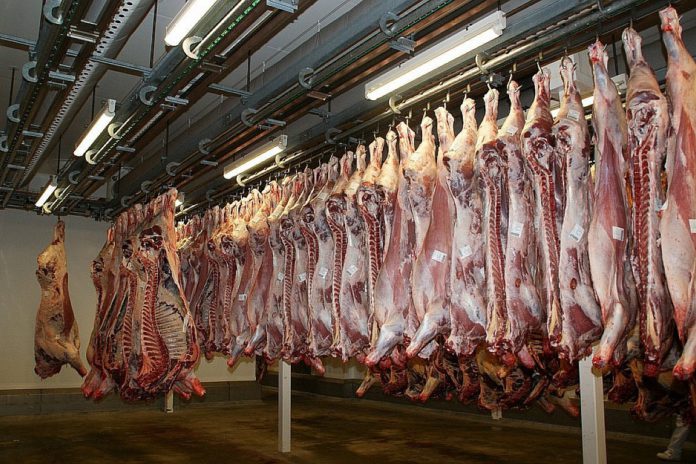In this article, That’s Farming looks at the science of marbling, nutritional management, animal cattle, carcass quality and genetics.
According to Science Direct, marbling is defined as the appearance of visible white flecks or streaks of intramuscular fat, detected visually between bundles of muscle.
Marbling is the fat within the actual muscle of the animal.
The content of intramuscular fat determines the level in beef.
This is one of the vital elements that influence the beef’s overall quality, including tenderness, juiciness, flavour, and colour.
Genetic, sexual, nutritional, and management factors of beef cattle impacts marbling.
Science of marbling
Marbling deposits slow and steady throughout the lifecycle of an animal. However, subcutaneous fat appears quicker and in larger quantities as an animal gets older.
Fat deposition in cattle varies with manipulation of the by-products of rumen fermentation. The bacteria in the rumen establish fermentation by-products known as volatile fatty acids from the feed.
An animal’s protein intake influences the marbling effect. Increasing protein content in the diet has the potential to increase starch digestion and, therefore, absorption in the intestinal tract.
According to research from the University of Illinois, an increment of protein in the diet in young calves increases marbling by up to 16%.
Nutritional management
At a young age, cattle develop marbling fat. To increase the amount of marbling, you can feed higher energy feed to young calves.
Research from the University of Illinois produced evidence that calves fed corn and grain-based creep feed resulted in higher marbling scores compared to calves fed fibre-based creep feed. This is due to the higher starch content of grains.,
A suggested tool for increasing marbling is to finish cattle on a highly digestible, grain-based diet.
In turn, this diet provides the highest level of net energy. This allows for high blood glucose levels and, furthermore, promotes adequate fat deposition.
Furthermore, you can creep-feed calves a high-energy diet after weaning.
Marbling can be improved through earlier weaning. Continued research from the University of Illinois showed that calves weaned at an age of 5 to 6 months and put directly onto a finishing direct had a higher marbling score in comparison to calves weaned at 7 to 8 months old.
Animal health
Healthy beef animals are a priority to produce healthy meat. You should implement adequate biosecurity measures across the full beef herd.
Preventing disease is the most desirable strategy for beef farmers who intend to improve the marbling of their beef.
Animal health is a priority when producing cattle for slaughter. Marbling is evidently reduced the more frequently animals become ill.
Sick cattle refusing to eat will use more energy to fight illness. Health cattle are vital for optimised beef marbling.
Carcass quality
Furthermore, you should feed cattle for optimal carcass yield, which is also important. Cattle on a low nutritional diet, which are underfed, will also result in less marbling.
Feeding excess concentrates for heavier weights results in the deposition of excess external fat, which creates a lower grade for the carcass.
In addition, a range of meat factories in Ireland, can, in cases, penalties for heavy cattle that exceed their desired carcass weight requirements.
Genetics and gender
It is moderate to highly heritable. Fluctuations in the nutrients during embryonic and foetal stages during the development of the fetus can influence the progeny’s meat quality.
Whether or not a cow is on a high or low plane of nutrition during her pregnancy can also influence the meat quality of the offspring.
The content of intramuscular fat varies for animals depending on breed, sex, age, and diet.
Gender is also a major influence on the intramuscular fat contents of skeletal muscles in cattle.
Furthermore, bulls tend to have a lower intramuscular fat content than heifers, despite being the same age and weight.
Age and weight
Slaughter ages and weights influence intramuscular content and marbling score.
A number of studies showed results that intramuscular content or marbling score has a positive relationship with slaughter weight.
The variation in intramuscular fat content or marbling score between ages and weights at slaughter may be due to factors including genetics, nutrition, and management.
In a review that Science Direct published, it stated that muscles need time to reach maturity. Extended fattening periods provide more time for the animal to obtain high levels of marbling.
Once a certain slaughter weight and age is reached, the feed efficiency decreases as muscle growth declines.
Furthermore, prolonging the period of fattening animals can increase backfat thickness. This leads to a detrimental influence on fattening grades.
Despite this, extending the fattening period also leads to reduced carcass quality and economic efficiency as it increases unwanted fat depositions, feed, and labour costs.
Castration
The castration of male calves generally improves marbling levels in some cattle breeds. This can be seen evidently in the Holstein-bred calves.
Moreover, castration promotes the intramuscular content, marbling score, and beef quality grade.
A critical factor for this positive influence is timing. Early castration at weaning increases the marbling score, while late castration imposes the opposite effect.
To conclude, there is a range of management strategies available that you can implement in your suckler herd or beef enterprise.
These factors have the potential to maximise the performance of your beef in the Irish market.
Other articles on That’s Farming this week:





